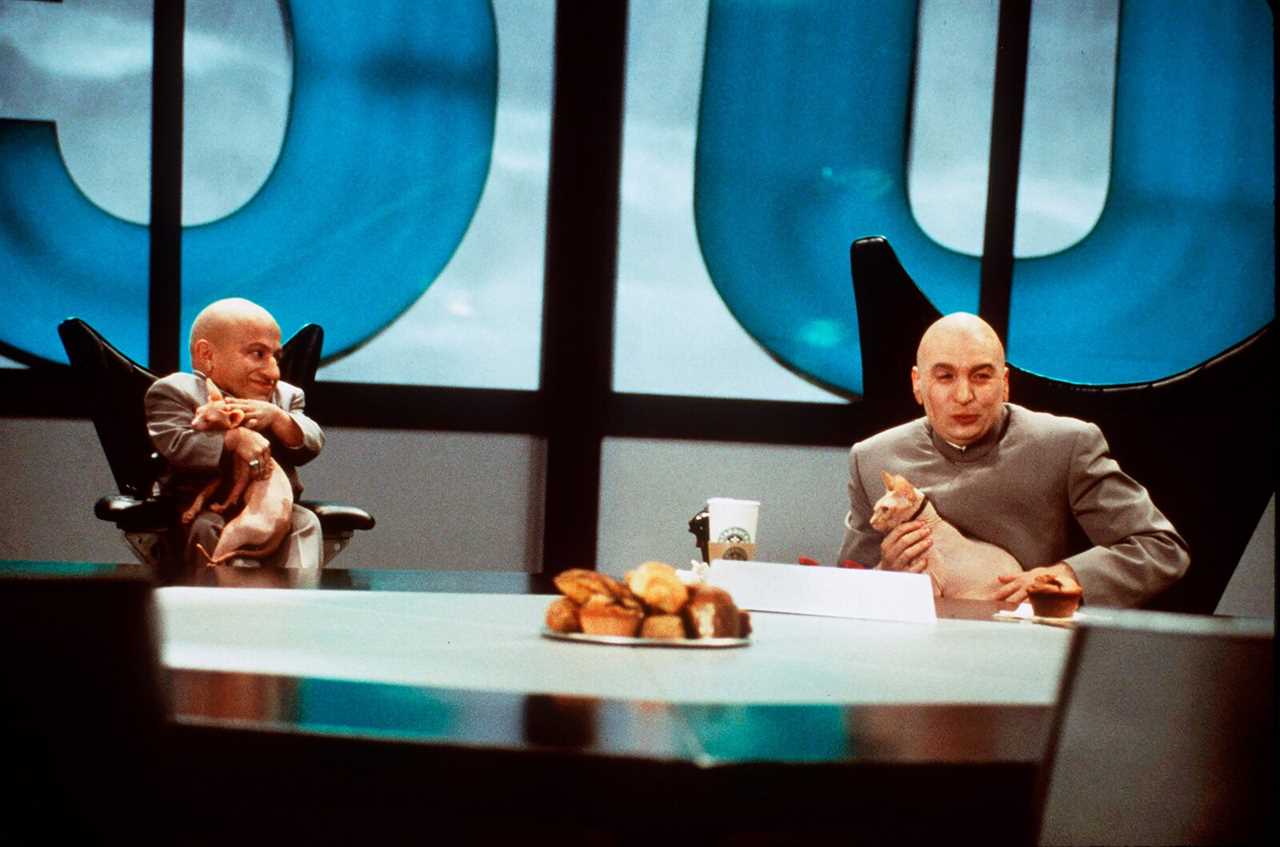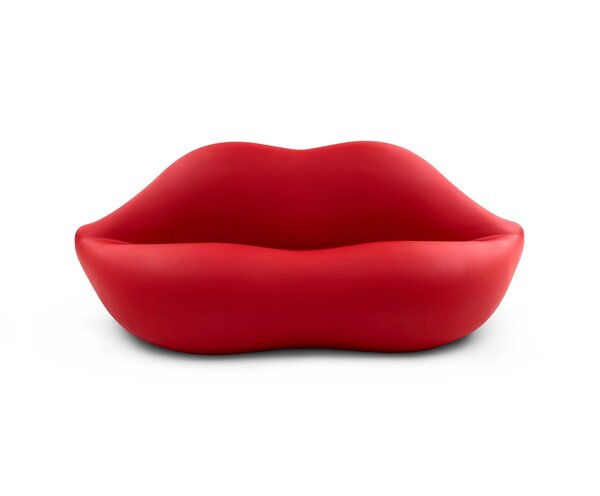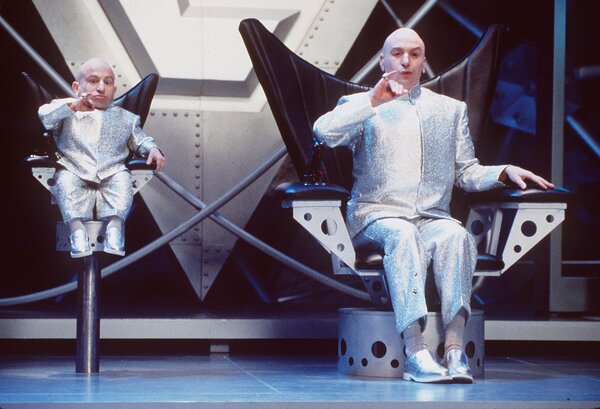The Bocca sofa, the Ox chair—if you look past the franchise’s exaggerated midcentury references, its design universe includes some of the era’s classics.

When Austin Powers: International Man Of Mystery came out in 1997, the satirical spy movie introduced the world not just to lasting catchphrases like "Yeah, baby, yeah" and "Oh, behave," but also its loud, kitschy late-1960s universe devised by production designer Cynthia Charette. Though it wasn’t until the franchise’s second film, Austin Powers: The Spy Who Shagged Me, released 25 years ago on June 8, that the "shagadelic" world was fully realized by production designer Rusty Smith (who went on to work on Austin Powers in Goldmember).
If you can look beyond the narrative ridiculousness and some of the more exaggerated references to midcentury style in the Austin Powers series, there’s some legit modernist design education to be had, thanks to set decorators Bob Kensinger (International Man of Mystery) and Sara Andrews (The Spy Who Shagged Me and Goldmember). Take, for instance, the multiple on-screen appearances of Studio65’s Bocca sofa, which resembles an oversize pair of lips, throughout the franchise. The avant-garde experimental collective of Italian architects and artists drew inspiration from Salvador Dali’s mid-1930s painting, Mae West’s Face which May be Used as a Surrealist Apartment, when they designed the loveseat for a fitness center in Milan in 1970. The sofa was produced by Italian furniture manufacturer Gufram and originally named Marilyn after the gym’s lipstick-loving owner, Marilyn Garosci, but it now goes by Bocca. It has since become a Pop art staple and was reissued by Heller in 2004.

The Bocca sofa by Italian avant-garde design collective Studio65 makes multiple appearances in the Austin Powers franchise. It’s also prominently featured on the poster for Austin Powers: The Spy Who Shagged Me, which was released 25 years ago on June 8.
Courtesy Heller
Though the Bocca sofa doesn’t play as key a role in the films as Austin’s round bed with its shiny satin sheets, it was featured prominently in The Spy Who Shagged Me’s promo material, which finds Mike Myers’s Powers perched on the bright-red, sculptural loveseat while his spy partner Felicity Shagwell (Heather Graham) lays seductively along its back. It’s amazing how one piece of furniture can suggest sex, comedy, and playfulness, all in a quick glimpse.
Elsewhere in Austin’s shag pad, the furnishings and fixtures pay a somewhat chaotic tribute to the Swinging Sixties, with Andy Warhol-inspired Pop art, multicolored carpeting, and kaleidoscopic walls that echo the designs of noted psychedelic and Pop artist Peter Max. At closer inspection, there are also some lasting modernist pieces sprinkled throughout. A red Nelson Marshmallow sofa, created by industrial designers George Nelson and Irving Harper for Herman Miller in 1956, for example, sits next to a chrome lamp made either by or in the style of Robert Sonneman, a well-respected creator of ’60s and ’70s atomic-style lighting fixtures.

While the chairs in Dr. Evil’s lair are cartoonishly over-exaggerated, the material palette pulls from popular modernist chairs of the era made with black leather and chromed steel.
Courtesy Getty Images
All of that stands in stark contrast to Dr. Evil’s lair, which sits inside an active volcanic island. While Evil’s seat of choice in the first movie was Danish designer Hans Wegner’s 1960 Ox chair—which is also said to have been inspired by Surrealist paintings from the ’30s, in this case artworks by Picasso—the villain’s chair in the second movie is a sort of souped-up version of the Sixty Two chair (also known as the 6250) by G Plan, a U.K. furniture manufacturer that really came into its own in the postwar modernism boom. Though the 6250 was arguably made famous as the chair used by fictional villain Ernst Stavro Blofeld in the 1967 James Bond movie You Only Live Twice, the design was first introduced to the public in 1962, when it was dubbed "the world’s most comfortable chair." Dr. Evil’s version of the swivel and rock wing chair is cartoonishly overblown, with a high V-back and its own joystick to enable dramatic turns.
Evil’s goons (and son) surround him in similar high-backed, black-leather-and-chromed-steel chairs that are absurd, but also fit in with the sleek material palette of other popular chairs of the era, including the aforementioned Ox chair, the cult-classic Eames lounge and ottoman, or Danish architect Arne Jacobsen’s Egg chair, among others. While the Austin Powers films are often written off as a series of crude farces—and, to be clear, they are—they’re also visual documents suggesting a sense of time, place, and comedy. The franchise’s "shagadelic" universe was over the top, but it created its own aesthetic and language that pulled from modernist design classics.
Top photo courtesy Getty Images, from "Austin Powers: The Spy Who Shagged Me" (1999)
Related Reading:
Are We Heading for Another Attempted Waterbed Revival?
How Midcentury Modern Met the Stone Age to Create Flintstones Chic
Read More
By: Marah Eakin
Title: Yeah, Baby, Yeah: "Austin Powers" Is Full of Modernist Furniture Cameos
Sourced From: www.dwell.com/article/austin-powers-modernist-furniture-design-cameos-bocca-sofa-ox-chair-20919c4c
Published Date: Mon, 10 Jun 2024 17:52:13 GMT
Did you miss our previous article...
https://trendinginbusiness.business/real-estate/is-this-prefab-design-website-the-future-of-homebuilding
.png)





